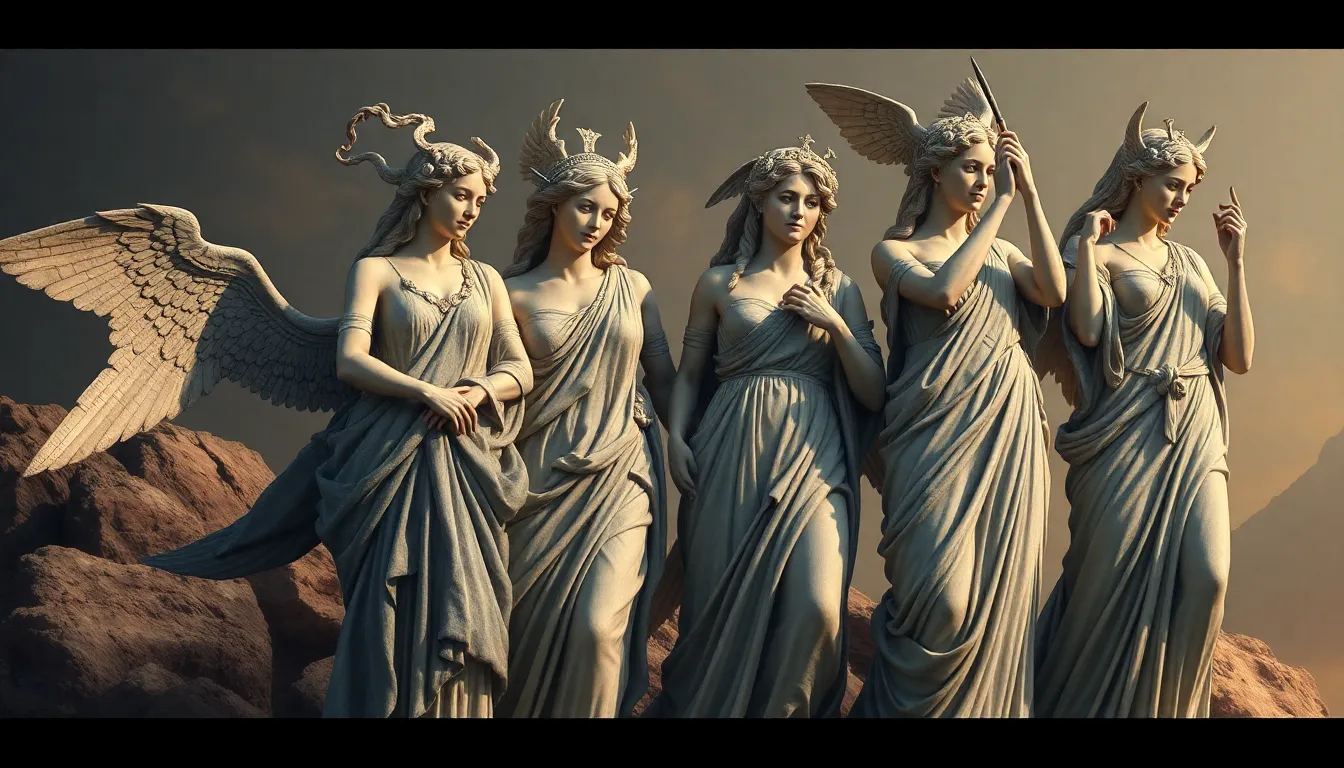The Muses and Their Representation in Cultural Studies
I. Introduction to the Muses
The Muses are a group of goddesses in Greek mythology who embody the arts and inspire creativity. Traditionally, they are considered the daughters of Zeus and Mnemosyne, the goddess of memory. Each Muse presides over a specific domain of the arts and sciences, providing inspiration to artists, poets, and thinkers throughout the ages.
Their roles and functions extend beyond mere inspiration; they represent the ideals of creativity and knowledge, playing a crucial part in the cultural fabric of ancient Greece. The Muses symbolize the importance of artistic expression and the pursuit of knowledge, making them an enduring subject of study in cultural studies.
II. The Nine Muses: An Overview
Each of the nine Muses has her own unique domain, symbol, and characteristics. Below is a brief description of each Muse:
- Calliope – The Muse of epic poetry, often depicted with a writing tablet or scroll.
- Clio – The Muse of history, represented with a book or scroll, symbolizing the recording of historical events.
- Erato – The Muse of lyric poetry, typically shown with a lyre, embodying the beauty of love and romantic expression.
- Euterpe – The Muse of music, often depicted with a flute, celebrating the joy and power of music.
- Melpomene – The Muse of tragedy, recognized by her tragic mask, representing the depth of human emotion.
- Polyhymnia – The Muse of sacred poetry, shown in a contemplative pose, symbolizing the spiritual and the divine.
- Terpsichore – The Muse of dance, frequently depicted dancing or playing a lyre, highlighting the art of movement.
- Thalia – The Muse of comedy, represented with a comic mask, bringing laughter and joy to audiences.
- Urania – The Muse of astronomy, often depicted with a globe or compass, symbolizing the study of the cosmos.
The symbolism associated with each Muse reflects the values and interests of ancient society, emphasizing the connection between the arts and the human experience.
III. The Muses in Ancient Art and Literature
Depictions of the Muses in classical art are abundant, often illustrated in frescoes, sculptures, and pottery. Artists sought to capture their ethereal beauty and divine presence, leading to a rich visual representation of these goddesses.
Literary references to the Muses abound in ancient texts, with poets frequently invoking their names at the beginning of works to seek inspiration. For example, Homer begins both the “Iliad” and the “Odyssey” by calling upon the Muses, emphasizing their role in the creative process.
Ancient artists and writers viewed the Muses as vital sources of inspiration, embodying the ideals of creativity and artistic expression. They served as conduits through which divine inspiration flowed, allowing mortals to create works that transcended ordinary experience.
IV. The Evolution of the Muses in the Renaissance
During the Renaissance, a period marked by a revival of interest in classical antiquity, the Muses underwent reinterpretation. They were seen as symbols of the humanistic ideals that emerged during this time, representing the pursuit of knowledge, beauty, and artistic excellence.
The Muses influenced the arts significantly, inspiring a new wave of creativity in literature, painting, and music. Notable Renaissance artworks featuring the Muses include:
- Raphael’s “The School of Athens,” where the Muses are represented alongside great thinkers of the past.
- Giorgio Vasari’s “The Muses,” which depicts them in a harmonious gathering, celebrating their collective influence.
- Michelangelo’s works, which often reflect the ideals of beauty and inspiration associated with the Muses.
These representations highlighted the Muses’ role as catalysts for artistic innovation and cultural flourishing during the Renaissance.
V. The Muses in Modern Cultural Studies
In contemporary artistic movements, the Muses continue to hold relevance. They are often referenced in modern literature, film, and music, serving as symbols of inspiration and creativity. Their influence can be seen in various genres, from poetry to cinema, highlighting the enduring power of their archetypes.
The Muses have also found a place in feminist and post-colonial discourse, where their representations are re-examined and critiqued. The traditional portrayal of the Muses as idealized female figures has led to discussions on gender roles in art and the representation of women in creative fields.
VI. The Muses and the Concept of Inspiration
The relationship between the Muses and the creative process is a central theme in discussions of artistic inspiration. In ancient times, they were believed to directly influence the thoughts and works of artists and writers.
Psychological interpretations of the Muses suggest that they can be seen as metaphors for the subconscious forces that drive creativity. The idea of the Muses as external sources of inspiration has evolved into a more introspective understanding of the creative process in modern contexts.
VII. Critiques and Reinterpretations of the Muses
Feminist critiques of the traditional representations of the Muses challenge the notion of women as passive sources of inspiration. Contemporary interpretations seek to empower the Muses, presenting them as active participants in the creative process.
Globalization has also impacted the understanding of the Muses, leading to a broader interpretation that includes diverse cultural perspectives. This shift has encouraged new narratives that challenge historical representations and embrace a more inclusive understanding of inspiration.
VIII. Conclusion
The Muses have left an enduring legacy in cultural studies, representing the intersection of creativity, knowledge, and artistic expression. Their significance extends beyond ancient Greece, influencing various cultural movements and discussions around gender, identity, and inspiration.
Studying the Muses provides valuable insights into the nature of cultural production, highlighting the ways in which art and creativity continue to evolve while remaining rooted in ancient traditions. Their story is a testament to the enduring power of inspiration and the arts in shaping human experience.




